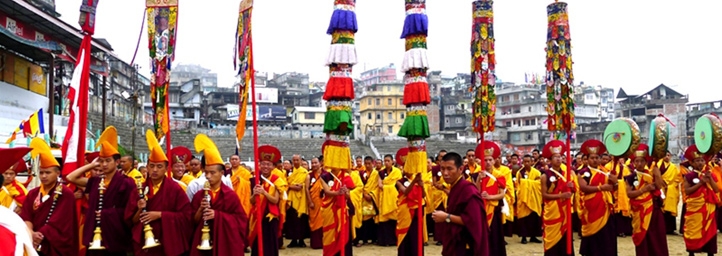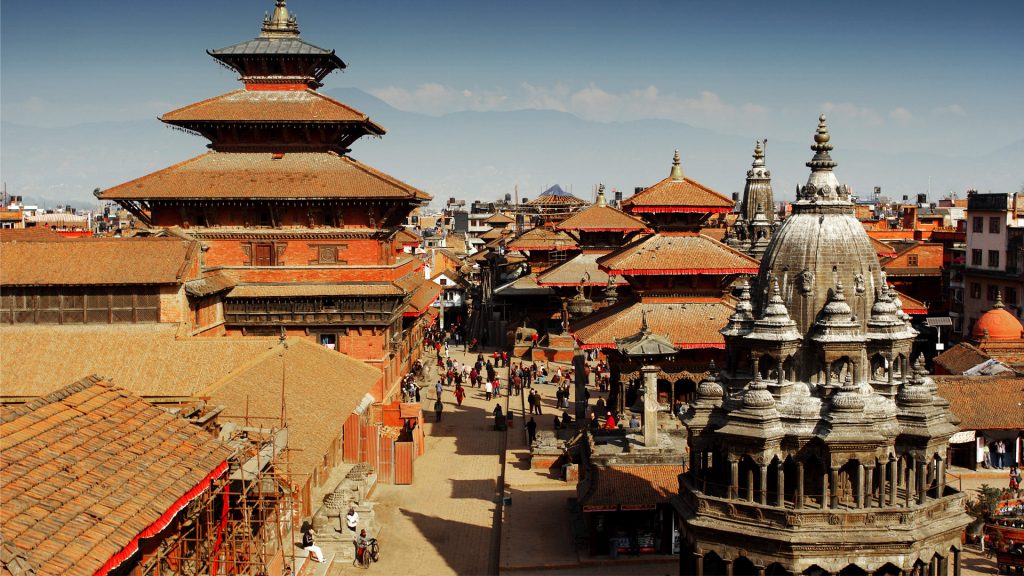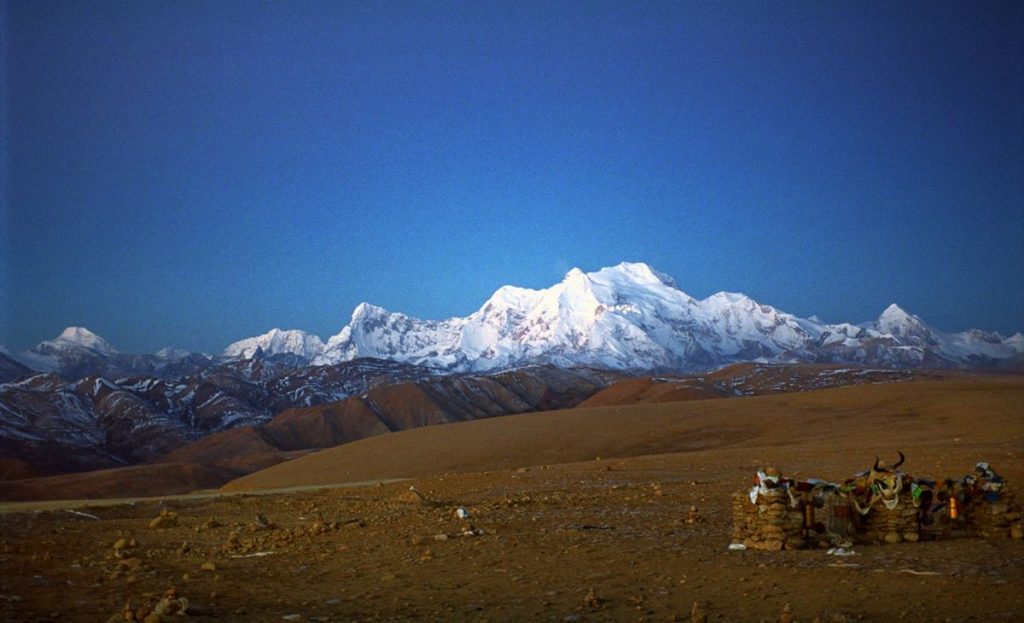Saga Dawa is called the “month of merits” for Tibetan Buddhists. Dawa means “month” in Tibetan, and “Saga” is the name of a star prominent in the sky during the fourth lunar month of the Tibetan calendar when Saga Dawa is observed. Saga Dawa usually begins in May and ends in June. The Saga Dawa Festival celebrates the birth, parinirvana (death), and enlightenment of Buddha, and it is believed that all positive and negative actions are multiplied as a result. For Tibetan Buddhists, the month of Saga Dawa is the most auspicious time for meritorious actions. Meritorious acts include pilgrimages to sacred places. There are many mountains, lakes, caves and other natural sites in Tibet that have attracted pilgrims for centuries, but for the Saga Dawa, the most auspicious place is the holy Mt. Kailash.
While the Saga Dawa is a whole month of meritorious actions, there is also the Saga Dawa Duchen, which is the day of the full moon in the sacred month of Saga Dawa. Traditionally, the holy day of Saga Dawa Düchen is observed through practice, generosity, and the performance of meritorious deeds. Sojin, the practice of Life Release, is commonly performed by purchasing animals that are destined to be killed (like worms, crickets, or fish), and releasing them into their natural habitats with prayers and positive aspirations. The act of giving life in this way is believed to extend the practitioner or benefactor’s lifespan and create positive circumstances.


The Saga Dawa Festival is an ancient festival that is celebrated across Tibet, and in other Buddhist countries as well. Tibetan Buddhists try to do what the Buddha said and give alms and pray. It is believed that praying and almsgiving and doing acts of benevolence during Saga Dawa and in the holy month after this multiplies the merited return to the giver far more than on regular days. The occasion is often dominated by monastic chanting, cham dances, and other religious activities. During the month, many Tibetans also refrain from killing animals. Tibetans believe that the fifteenth day of the month is very special, as Sakyamuni was born, attained Nirvana (enlightenment), and stepped into Parinirvana (death) on this same day.
The Saga Dawa Festival Trek lets you enjoy the unique culture of the Tibetan people of Simikot. The Saga Dawa Festival is an extremely spiritual experience for all involved, including the tourists. There is a distinct feeling of reverence throughout the proceedings, since the main point of the festival is to pray. Buddhists believe that the main aim of the festival season in Tibet is to pray for the long life of all the holy gurus of all traditions, for the survival and spreading of Buddha’s teachings in the minds of all sentient beings, and for world peace. Moreover, visitors not only get to watch and experience the solemn Buddhist activities, they also get to join in with the prayers, kora, offering of tips to the poor, and can spend time touring some of the monasteries of Tibet during this holy month-long festival.
From Kathmandu, you will take a flight to the Nepalgunj. It is the town in the Western Terai and is very close to the Indian Border and the Bardia National Park. The town is a major transport hub for western, mid- western and far- western regions of Nepal.


On the following day, you will fly from Nepalgunj to Simikot. The trip is a thrill ride through the ridges and ravines in the spectacular mountains. The landing at the tiny mountain airstrip at Simikot is an unforgettable experience. It is no less adventure as it is just a graveled airstrip. You feel like you are in a different realm because of the sudden rise in altitude and sudden fall in temperature. To leave behind the scorching hot climate behind, to be in a tiny mountain village and to be breathing cool and fresh air gives you an adrenaline rush and refreshing feel. Simikot is situated on an airy spur above the Humla Karnali River and you should take time to explore the town and some of the surrounding villages to discover a way of life that has barely changed in hundreds of years.
You will commence your trek, climbing up from the airstrip on a rocky trail passing fields of barley and wheat. You will then ascend a forested ridge above the town of Simikot. From there it is a descent of about an hour to Mazgaon. You have to trek through the pine forest where you can see local Hindu and Buddhist people in their traditional attire accompanied by their herds of cattle. Once you pass Majgaon, the track gets uneven. On one corner it is descent whereas on the next corner it is ascent. This particular topography is called Nepali flat. It is green and lush than what you will see a little higher.
From Dhara Pokhari, the trail is a bit steep until you cross a long slope and follow the river to a waterfall near the shepherds’ camp at Chachera. You will then climb over a ridge and bypass the village of Kermi before entering a big valley with walled fields of potato and buckwheat. After walking through a sparse pine forest you will descend from the ridge to the Salli Khola and camp by the river.
Leaving Salli Khola, you will continue your trail to Muchu. Crossing the river, we then climb over a rocky ridge before descending to the grey waters of Humla, Karnali. Then you can see a goat herders camping by the river in a sandy meadow after crossing another ridge. The valley gradually narrows and we cross several more ridges, passing the villages of Yalbang and Yangar. The trail then winds its way precariously above the river before you cross a suspension bridge to the village of Muchu.
The first rest day will be at Muchu. You can simply relax on this day of walking around Muchu. This day is best for acclimatization too. We can explore the valley around Muchu and explore the village with its stone houses and Gompa.


After a day’s rest at Muchu, you will move forward and follow the trail over a ridge to the Tumkot Khola. Continuing your trial , you will walk along the rocky stream bed for a short distance before beginning a steep climb through a rock-filled gully. You will then pass through Palbang and its bright yellow mustard fields to the small settlement of Yari and beyond here the route climbs up the valley towards a pass, the Nara Lagna.
Today, you will have a very steep ascend to the top of Nara Lagna (4580 m). Then our trail descends. On the route, you can have the view of the Tibetan Plateau before arriving at the village of Ranipauwa. Walk carefully, since you may slip and slide on a surface of loose pebbles down to the Humla Karnali.
Leaving Hilsa, you will commence your trek to Taklakot. You have to cross the Nepal -Tibet border which is marked only by a stone pillar. This might be the most informal border crossing you might see throughout your lifetime. Taklakot is the largest trading center from where you will be driven to Mansarovar, the most venerated of Tibet’s many lakes. It is a rough fantastic drive that gives a taste of what lies ahead. It is an incredible drive past the snow capped peak of Gurla Mandata (7728m) as the road climbs higher onto the Tibetan Plateau.
In places the road is no more than the tracks of vehicles that have passed this way before. Today you will be sent to the highest lake of fresh water with turquoise complexion in the world. It is full of fishes and swans. Holy Kailash Parbat, Mt. Gurula-Mandala, Lake Rashekshi are lying on its surrounding. The region is considered rich for gold and other mines, hot springs and hundreds of wild living creatures. You pass through Tibetan villages where prayer flags flutter from the roofs of the whitewashed houses.
You will be spending a day in Mansarovar allowing your bodies to acclimatize to the altitude and exploring this fascinating place. We will visit the picturesque Chiu Monastery on the North West shore of the lake with the imposing sight of Mt Kailash in the background. The scenery is stunningly beautiful with panoramic views of the Himalayas.
Holy Mansarovar is the lake of compassion, tranquility and bliss. After completing the memorable morning bath and puja you will be heading for Holy Mansarovar Parikrama by land cruiser with packed lunch and continue to drive towards Tarchen (Darchen). If time permits, you will visit Chui Gompa. Tarchen is considered as a base camp for Holy Kailash Parikrama. During the auspicious pilgrimage time, this place will be flooded with pilgrims with hundreds of tents all around.


The Saga Dawa festival is celebrated on the 15th day of the 4th Tibetan month and is one of the most important religious festivals celebrated in Tibet. This auspicious day coincides with three important events in Buddha’s life namely his birth, nirvana and parinirvana (death). Since the Saga Dawa festival falls on the holiest month of the Tibetan calendar, it is believed that good deeds and prayers are multiplied thousand fold during this event. So you can see everyone immersed in prayers trying to please the god.
After breakfast drive to Tarboche , the starting point of Kailash Parikrama. Tarboche is also known as outer “Asthapath”. Similarly, it is one of the exciting days walking along the beautiful rocky cliffs; waterfalls with some clouds in the clear blue sky make you feel that Great God Shiva is everywhere with tons of blessings to you. Time to time the face of Kailash Parbat will keep on appearing. For a 7 km trail it takes almost 7 hrs.
Today you will be climbing to Drolma-la (Dolma-La 18600ft) and then descending gradually to Zuthulpuk (4760m). Yamasthal should be crossed to reach the Shiva-sthal while your steps go closer to the pass.
Morning free time to explore the caves, temples and shrines around Milarepa cave. After walking 3 hours, all the driving crew will be waiting for your arrival. By late afternoon you will be at your lodge in Dongba.
It is about 7 to 8 hours drive to Nyalam from Dongba.


This is the last day of the trip where you will drive through the beautiful hills, river valleys and cultural villages to reach the Kathmandu Valley.
Shopping is my option in contrast to Red Bull. Regardless…


Hundreds of years of preservation and perseverance, nourished and timely…
Among the many 12 years festivals Nepal has, Lha Phewa…